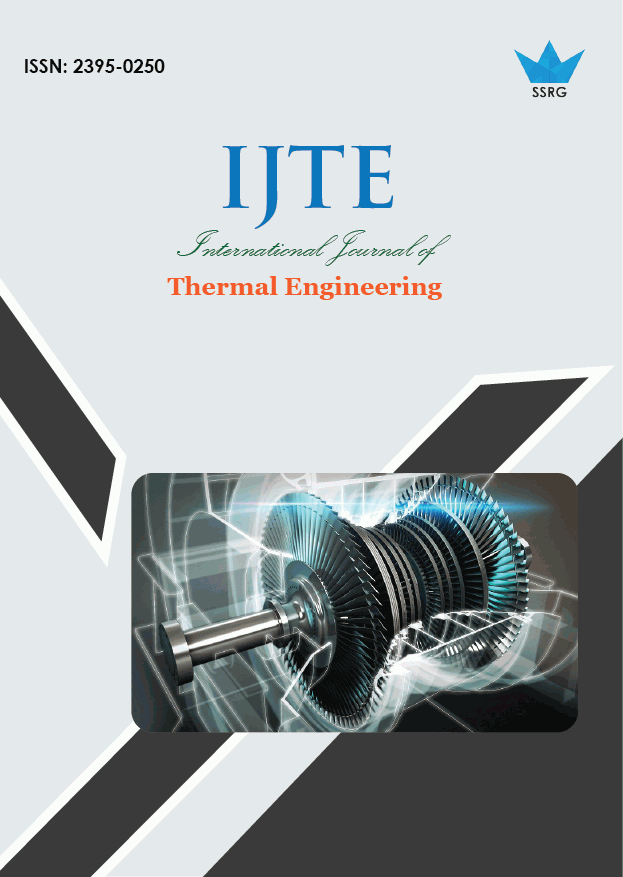Impact of different volume concentrations and flow rates on the thermal performance of counter flow cylindrical shell and helical coil heat exchanger using Cu/H2O nano fluids

| International Journal of Thermal Engineering |
| © 2020 by SSRG - IJTE Journal |
| Volume 6 Issue 3 |
| Year of Publication : 2020 |
| Authors : D.Sarath Chandra, Dr.Omprakash D Hebbal, Dr. K.Vijaya Kumar Reddy |
How to Cite?
D.Sarath Chandra, Dr.Omprakash D Hebbal, Dr. K.Vijaya Kumar Reddy, "Impact of different volume concentrations and flow rates on the thermal performance of counter flow cylindrical shell and helical coil heat exchanger using Cu/H2O nano fluids," SSRG International Journal of Thermal Engineering, vol. 6, no. 3, pp. 11-15, 2020. Crossref, https://doi.org/10.14445/23950250/IJTE-V6I3P103
Abstract:
Laminar flow convective heat transfer and pressure drop characteristics of Cu-water nanofluids at low temperatures (30-70oC) in counterflow shell and helical coil heat exchanger (SHCHE) are experimentally investigated. Further experiments are carried out using natural water with the same setoff parameters. Experiments are also conducted with volume concentrations of 0.01–0.06 vol % and the Reynolds number varies between 700 to 2100. The heat transfer rate is increased by using 0.06 vol. % Cu/water single fluid with high flow rate on the shell side in the helical coil counter flow heat exchanger. The average Nusselt number increased with increasing Re number and particle concentrations. The experimental study shows that the maximum thermal performance in Copper/water single is about 14% higher than that of distilled water.
Keywords:
Helical coil Heat Exchanger, Nanofluids, Volume Concentrations, Flow Rates, convective heat transfer;
References:
[1] Ender Ozden, Ilker Tari, “Shell side CFD analysis of a small-and –tube heat exchanger”, Energy conversion and management 51 (2010) 1004-1014
[2] Kyo Sik Hwang, Seok Pil Jang, Stephen U.S.Choi, “Flow and convective heat transfer characteristics of water-based AL2O3 nanofluids in fully developed laminar flow regime”, International journal of heat and mass transfer (2008)
[3] M.H.Kayhani, H.Soltanzadeh, M.M.Heyhat, M.Nazari, “Experimental study of convective heat transfer and pressure drop TiO2/water nanofluid”, International communications in heat and mass transfer 39 (2012) 456-462.
[4] Zeinab Talaei, Ali Reza Mahjoud, Ali Morad Rashidi, “The
effect of functionalized group concentration on carbon nanotube fluid’s stability and thermal conductivity as heat transfer media”, International communications in heat and mass transfer 38 (2011) 513-517.
[5] Min-Sheng Liu, Mark Cheng Lin, I-Te Huang, Chi-Chuan Wang, “Enhancement of thermal conductivity with carbon nanotube for nanofluids”, International Communications in heat and mass transfer 32 (2005) 1202-1210.
[6] Amith Kumar S.Puttewar, A.M.Andhare, “Design and thermal evaluation of shell and helical coil heat exchanger”, International journal of research in engineering and technology 4 (2015) 416-423
[7] Vikas Kushwaha, Wasim Shaikh, Ronak Shukla, Rushabh Panchal, "Design and Parametric Analysis of Helical Coil convective type Heat Exchanger" SSRG International Journal of Mechanical Engineering 4.7 (2017):33-39.
[8] Su Thet Mon Than,Khin Aung Lin, Mi Sandar Mon, “Heat exchanger design”, International Journal of Mechanical and mathematics engineering 2 (2008) 1151-1158.
[9] Gafurama James, V.N.Kapatkar and A.B.Korane, “Experimental analysis of shell and coil heat exchanger using Wilson Plot Technique”, International engineering research journal (2017) 1-6.
[10] H.R.Allahyar, F.Hormozi, B.Zare Nezhad, “Experimental investigation on the thermal performance of a spiral heat exchanger using a new hybrid nanofluid”, Experimental thermal and fluid science 76 (2016) 324-329.
[11] Swapnil Ahire, Purushottam Shelke,Bhalchandra Shinde and Nilesh Totala, “Fabrication and analysis of counter flow helical coil heat exchanger”, International journal of engineering trends and technology 15(2014) 229-240

 10.14445/23950250/IJTE-V6I3P103
10.14445/23950250/IJTE-V6I3P103